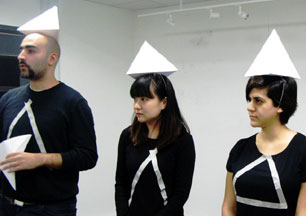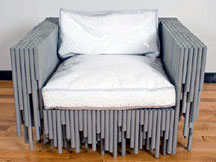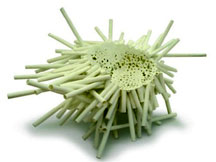Sunday 1 April, 2012, 18:59 - Radio Randomness
One major problem facing many authorities across the world, is the transient nature of radio transmissions. For example, tracking down a radio transmitter requires the transmitter to be active in order for its direction to be sensed. Equally, for those bodies (such as the security services) who wish to capture radio transmissions of various sorts, especially those thay may be of short duration, the only way is to place sophisticated and costly wide-bandwidth receivers in a particular location which record everything they receive onto a hard disk, the data from which has to be analysed at great expense.How much simpler it would be, if there were a device or material of some kind which would 'capture' any radio transmission and then store it such that it could be collected at a later date. Such a device should ideally:
- require no power source to operate;
- be able to store transmissions for an indefinite period;
- be deployable and collectable by untrained agents;
- not look out of the ordinary such that it does not arouse suspicion;
- capture even the shortest burst of transmissions.

Professor Lilo and his team
It is also not necessary to actually strike the chime for it to begin resonating. If a tuning fork which produces the same tone as a chime is held next to it, the chime will 'super-resonate' with the tuning fork and begin to reproduce the tone. If a tuning fork were held next to a chime in a frictionless environment, the chime would continue to produce the tone indefinitely, long after the tuning fork were removed from the area.
Using this concept, Professor Lilo has developed the 'super-resonant frequency memocorder' (or Spereo Quemord for short). The concept is almost identical. A dipole antenna mounted in a frictionless radio environment, which is one in which no alternative electromagnetic fields can 'usurp' or 'slurp' the energy contained in the dipole (known as an 'anti-uslurp field' such as that found in certain Faraday cages) will continue to resonate and thus repeat and store any signals which excite it. The difficulty is coupling the dipole to the outside world whilst maintaining the anti-uslurp field and it is this element of the 'Spereo Quemord' which is still under wraps.
By using a number of Spereo Quemords of different but similar sizes, it is possible to store and record radio transmissions over a range of frequencies. Retrieving any signals stored is simply a case of removing the anti-uslurp field at which point the stored signals are re-radiated from the dipoles directly replicating the transmission which originally excited the Quemords.
 The first prototype of the device was built unobtrusively into a piece of chair-shaped lounge furniture and placed into the waiting room in the University's health centre. At the end of the day, the device was taken back to the laboratory where the elements of the device which generate the all-important anti-uslurp field were removed. The team at the University were able to recover some 2G and 3G mobile signals as well as several hours of WiFi, a number of short transmissions from a passing security van and even the lunchtime news on the local community television station, 'Travnja budale šala TV' (TBS).
The first prototype of the device was built unobtrusively into a piece of chair-shaped lounge furniture and placed into the waiting room in the University's health centre. At the end of the day, the device was taken back to the laboratory where the elements of the device which generate the all-important anti-uslurp field were removed. The team at the University were able to recover some 2G and 3G mobile signals as well as several hours of WiFi, a number of short transmissions from a passing security van and even the lunchtime news on the local community television station, 'Travnja budale šala TV' (TBS).  Flushed with their success, Professor Lilo and his colleagues have gone on to build a piece of furniture made exclusively of Spereo Quemords which they have used to demonstrate its capabilities at various venues. Their greatest achievement to date was to record and reproduce very weak signals from GPS satellites causing all the GPS devices in the room to show their position as being that where the device was originally located (and where it recorded the signals) and not in the room in which it was being demonstrated!
Flushed with their success, Professor Lilo and his colleagues have gone on to build a piece of furniture made exclusively of Spereo Quemords which they have used to demonstrate its capabilities at various venues. Their greatest achievement to date was to record and reproduce very weak signals from GPS satellites causing all the GPS devices in the room to show their position as being that where the device was originally located (and where it recorded the signals) and not in the room in which it was being demonstrated!The next stage is to attempt to reduce the size of the Quemords which Professor Lilo believes will be possible using room-temperature super-conductors which will allow the dipoles and the anti-uslurp field generators to be made almost infinitely small. They believe that it should be possible to develop a device which records and stores all transmissions on all frequencies in a unit no larger than a typical mobile phone, or small piece of fruit.
As always, Wireless Waffle likes to keep you up to date with the latest developments in radio technology. Rest assured that as soon as there is any further news on this exciting piece of radio technology, you will here about it here first.
